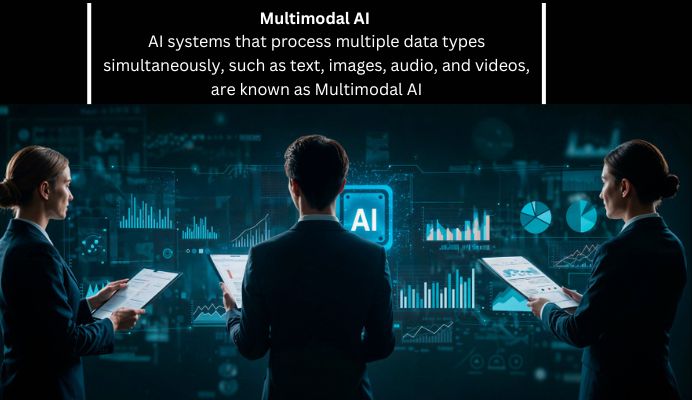
Multimodal AI – Meaning, Capabilities, and Use Cases
Introduction
Artificial Intelligence is more advanced, and one of the biggest leaps forward is multimodal AI. If you’ve ever talked to a voice assistant, uploaded a photo to search for similar images, or seen an app generate art from text prompts, you’ve already experienced the power of AI that works across different kinds of inputs.
Unlike traditional AI systems that focused on just one area—like text-based chatbots or image recognition software—multimodal AI can process and combine multiple types of information, such as text, images, speech, and even video, to better understand and interact with the world.
What is Multimodal AI?
Multimodal AI is a type of artificial intelligence that can process, combine, and analyze information from multiple types of data—such as text, images, audio, and video—at the same time.
Unlike traditional AI systems, which often work with just a single kind of input (like only text or only images), multimodal AI brings together data from different sources or “modalities” to gain a more comprehensive understanding of tasks and generate more nuanced outputs.
This fusion of diverse data types allows the system to perform more complex functions, similar to how humans use sight, sound, and language together to make sense of the world.
How does Multimodal AI differ from Single-modal AI?
Multimodal AI differs from single-modal AI in several ways:
1. Data types handled:
- Single-modal AI is designed to process and analyze just one type of data at a time—such as text, images, or audio. For example, a text-only chatbot or an image recognition system that cannot understand spoken language or integrate visual and auditory information.
- Multimodal AI, on the other hand, can process and integrate information from multiple data types simultaneously, such as combining images, text, audio, and even video. This allows it to understand complex scenarios and contexts that a single-modal system would miss.
2. Contextual understanding
- Single-modal AI has a limited view based solely on its data type, which means it might miss important contextual clues provided by other data formats.
- Multimodal AI provides a richer, more holistic understanding by cross-referencing and synthesizing different data sources, just as humans use their various senses together to interpret the world more accurately.
3. Capabilities
Tasks that require connections between different kinds of information—like describing what’s happening in a video using both audio and visual data are out of reach for single-modal AI, but are straightforward for multimodal systems.
4. Applications
- Single-modal AI remains valuable for specialized, focused tasks.
- Multimodal AI enables more versatile, robust, and human-like applications such as virtual assistants that interpret speech and visual cues at the same time, or medical AI that analyzes patient records, images, and test results together for comprehensive diagnostics.
Key capabilities of Multimodal AI
The key capabilities of multimodal AI revolve around its ability to combine, interpret, and generate insights from multiple types of data sources.
Here are the main ways in which multimodal AI stands out:
1. Integrated understanding across modalities
Multimodal AI can analyze and make sense of information from different data types, such as text, images, audio, video, or sensor signals, simultaneously. For example, it can read a sentence, analyze a related picture, and understand the connection between them, leading to more accurate comprehension and responses.
2. Cross-modal tasks
It enables new kinds of tasks like:
- Image Captioning: Generating descriptive text for a given image.
- Visual Question Answering: Answering questions about visual content.
- Speech-Text Alignment: Transcribing spoken words into written text or responding to spoken queries about visual content.
- Multimodal Summarization: Summarizing content that includes text, visuals, and audio.
3. Improved contextual awareness
By combining clues from different modalities, multimodal AI reduces ambiguity and can infer richer meaning. For example, by listening to the tone of voice and analyzing facial expressions in a video, it can better interpret emotions or intent than by voice or image alone.
4. Natural human-like interaction
Multimodal AI can interact in ways that feel more intuitive and human, recognizing and responding to users using multiple forms of communication (e.g., spoken questions paired with gestures or images).
5. Generative abilities
It can generate outputs in various modalities, such as producing images from text descriptions, or creating audio from written instructions—a hallmark of modern creative AI tools.
Use cases of Multimodal AI
The use cases of multimodal AI include the following
- Healthcare: Multimodal AI integrates medical imaging, electronic health records, and patient notes to improve diagnosis and personalized treatment.
For example, IBM Watson Health uses this approach to combine data for accurate disease detection and better patient outcomes. Diabetes management apps employ multimodal AI to tailor meal plans and monitor health via wearable device data.
- Automotive: Self-driving cars rely on multimodal AI to combine sensor data from cameras, radar, lidar, and GPS for safe navigation and decision-making. Toyota uses multimodal generative AI to create interactive digital owner’s manuals that blend text, images, and contextual info for a better user experience.
- Finance: Multimodal AI helps analyze transaction logs, user activity, and financial documents to detect fraud and assess risks more precisely. JP Morgan’s DocLLM uses this technology to improve document processing and compliance.
- eCommerce: Platforms like Amazon use multimodal AI to enhance product recommendations by analyzing images, user reviews, and purchase history, improving customer satisfaction.
- Education: Duolingo integrates text, audio, and visuals with multimodal AI to create personalized and engaging language learning experiences.
- Manufacturing: Companies like Bosch use multimodal AI to monitor machinery by analyzing sensor data, audio signals, and visual inputs, enabling predictive maintenance and quality control.
- Retail: Walmart uses multimodal AI combining shelf cameras, RFID, and transactions to optimize inventory management and personalize promotions.
- Consumer Technology: Google Assistant merges voice recognition, natural language understanding, and visual data to offer more context-aware and interactive responses.
- Agriculture: John Deere employs multimodal AI integrating satellite images, sensors, and weather data to optimize crop management and farm efficiency.
How does multimodal AI work?
Multimodal AI works by combining and processing multiple types of data, such as text, images, audio, and video, through a series of specialized steps and components.
1. Input modules
Each type of data (or modality) is first processed separately by a dedicated encoder specialized for that data type. For example:
- Text is processed by natural language models that transform words into meaningful numerical representations.
- Images are analyzed using convolutional neural networks (CNNs) that extract features like shapes, colors, and textures.
- Audio inputs might be converted into features reflecting rhythm and tone. These encoders reduce complex raw data into simplified feature vectors (embeddings) that capture essential information.
2. Fusion module
After encoding each modality, the AI combines these separate data representations into a single unified form. This fusion process integrates the complementary information from different data types so the system can understand relationships and context across modalities.
Fusion can happen in different ways—early fusion (combining data early in the process), late fusion (combining after individual processing), or hybrid techniques that blend strategies for best results.
3. Cross-modal alignment and reasoning
The system uses mechanisms like attention layers to focus on relevant parts of each modality and understand how they relate to each other. For example, when describing an image, the model might focus on specific visual elements while generating corresponding text.
4. Output module
Finally, based on the fused information, the AI generates outputs—which may be an answer, a caption, a classification, or even a generated image or audio. The output module interprets the combined data to perform tasks such as answering questions about images, transcribing speech with visual context, or generating new content across modalities.
Future of Multimodal AI
The future of multimodal AI is poised to transform how we interact with technology by enabling machines to understand and respond with human-like perception and intelligence across multiple senses.
Here’s what to expect:
1. More human-like interactions
Multimodal AI will enable more natural and seamless communication with devices, blending speech, vision, gestures, and contextual understanding. This will make virtual assistants, customer support, and robots feel more intuitive and responsive than ever before.
2. Advances in general-purpose AI
By integrating a wider variety of data types effectively, future multimodal AI systems will move closer to artificial general intelligence (AGI) — AI that can perform a broad set of tasks with contextual understanding and adaptability similar to humans.
3. Breakthroughs in healthcare and education
Future multimodal AI will revolutionize personalized medicine by combining patient history, medical images, and real-time sensor data for highly accurate diagnostics and tailored treatments. In education, it will create immersive, adaptive learning environments that respond to audio, visual, and behavioral cues.
4. Creative and generative technologies
The ability to generate rich, multimodal content (text, images, video, and audio) will fuel new forms of digital creativity, from art and entertainment to marketing and design, letting users co-create with AI in innovative ways.
5. Increased accessibility and inclusion
Multimodal AI will further advance assistive technologies by combining speech, text, image, and gesture recognition to empower people with disabilities through personalized and context-aware tools.
6. Ethics, fairness, and governance
As multimodal AI becomes widespread, there will be growing emphasis on addressing ethical concerns like bias, privacy, and misinformation to ensure responsible and fair deployment.
7. Widespread adoption across industries
Sectors such as autonomous vehicles, smart cities, manufacturing, and agriculture will leverage multimodal AI for enhanced perception, decision-making, and operational efficiency.
Conclusion
Multimodal AI represents a significant step forward in the evolution of artificial intelligence—moving beyond the limitations of single-source data to a richer, more integrated understanding of the world. By combining text, images, audio, and other data types, multimodal AI enables machines to interact with humans and their environments in ways that feel more natural, intuitive, and effective.
From healthcare and automotive to creative arts and education, its applications are expanding rapidly, showcasing the transformative potential of this technology. As multimodal AI continues to advance, it will not only enhance the capabilities of intelligent systems but also bring us closer to a future where AI truly understands and assists us across all aspects of life. Embracing this exciting frontier offers endless possibilities for innovation and improved human-machine collaboration.






